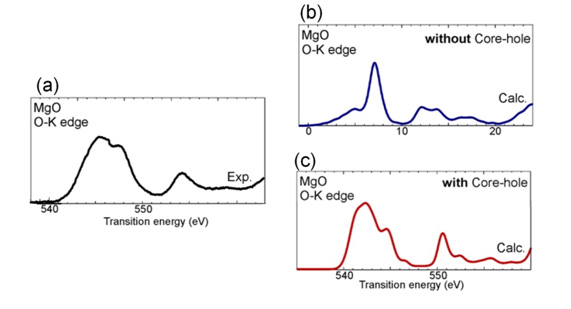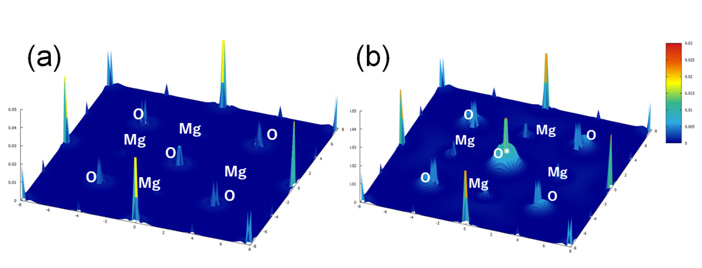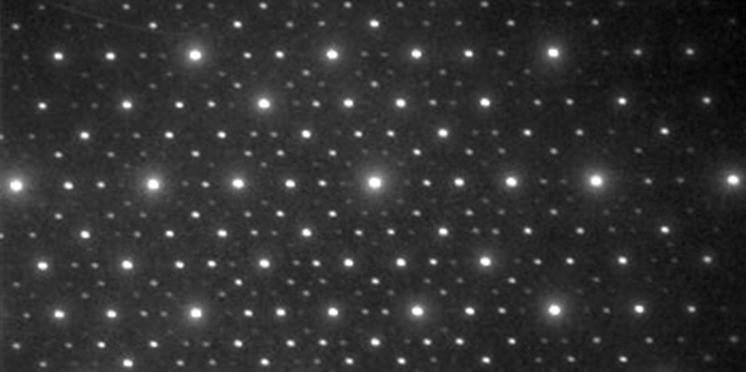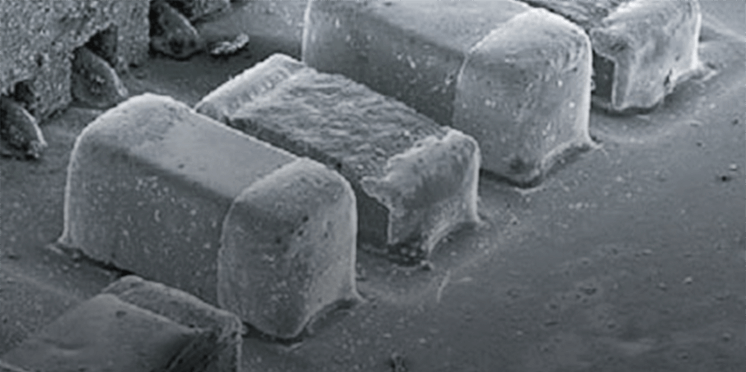コアホール相互作用
コアホール相互作用
core-hole interaction
[目次:分光分析(EELS/EDS/電子構造)]
内殻の電子が励起されて伝導帯へ遷移するとき、内殻にできたホール (内殻空孔,コアホール) と励起された電子との間のクーロン相互作用や内殻空孔が電子構造に及ぼす影響の総称。金属の場合は、自由電子がコアホールの影響を遮蔽するのでコアホール相互作用は小さいが、自由電子がない酸化物の場合には相互作用は大きい。
酸化物などの絶縁体から得られるEELSの吸収端近傍微細構造 (ELNES) は、内殻にホールを導入しない理論計算ではよく再現されないことが知られていた。この問題を解決するために考え出されたのが、コアホール相互作用である。コアホール相互作用を取り入れてELNESスペクトルを計算すると、実験で得られる吸収端スペクトルが、理論スペクトルによって格段に良く再現されるようなる。EELSにおいて、コアホール相互作用があると吸収端が低エネルギー側にシフトする。励起された電子とホールのエネルギー差が小さいほど効果は大きい。
図1(a)に、酸化物である酸化マグネシウム (MgO) から実験で得られたO-K ELNESスペクトルを示す。図1(b)に内殻空孔を導入しない場合の計算スペクトルを示す。計算されたスペクトルの形状が、実験で得られたスペクトルの形状に対して一致していないことが分かる。図1(c)に、酸素の内殻 (1s) に空孔を導入して、励起された電子に対するクーロン力が強くなる効果 (コアホール相互作用) を取り入れて計算したELNESスペクトルを示す。コアホール相互作用を取り入れて計算したELNESスペクトルと実験で得られたスペクトルの一致度が格段に改善していることが分かる。ELNESの理論計算のスペクトルの説明にはコアホール相互作用を考慮することの重要性が理解できる。
図2に、中央の酸素原子 (O*) の1s軌道に、内殻空孔がない場合 (図2(a)) と内殻空孔を導入した場合 (図2(b)) の伝導帯電子の波動関数の二乗を示す。内殻空孔を導入しない場合 (図2(a)) に比べて、内殻空孔を導入した方 (図2(b)) が、波動関数の二乗の強度が中央の酸素原子近傍で高くなっている。これは、空孔を導入したために酸素原子の近傍で伝導電子の感じるクーロン力が強くなったためである。このように、コアホール相互作用は、波動関数の局所的な空間的形状に影響を及ぼしていることが分かる。
(東京大学 溝口照康教授による)

図1 MgOのO-K ELNESスペクトル
(a) 実験で得られたELNESスペクトル
(b) 計算によるELNESスペクトル: コアホール相互作用(内殻空孔)を導入しない場合
(c) 計算によるELNESスペクトル: コアホール相互作用(内殻空孔)を導入した場合
コアホール相互作用を取り入れて計算したELNESスペクトルが実験で得られるスペクトルと良く一致していることが分かる。

図2 MgO (001)の伝導帯における電子の波動関数の二乗、内殻空孔の有無による違い
(a) コアホール相互作用(内殻空孔)を導入しない場合
(b) コアホール相互作用(内殻空孔)を導入した場合
酸素の1s軌道に内殻空孔を導入すると (図2(b))、導入しない場合 (図2(a)) に比べて伝導帯の波動関数の存在確率が酸素の原子近傍でより大きくなっていることが分かる。
Core-hole interaction means a Coulomb interaction between a hole created in an inner shell (a core-hole) and an excited electron, and the effect on the electronic structure caused by the core-hole. In the case of metals, the effect of the core-hole interaction is small because the free electrons screen the effect of the hole. However, in the case of oxides, the effect is large because oxides have no free electrons.
It has been known that conventional theoretical calculations cannot provide a good agreement with the experimental spectrum of an energy-loss near-edge structure (ELNES) in an EELS (electron energy-loss spectroscopy) spectrum obtained from an insulator (oxides, etc.). To solve this problem, the core-hole interaction has been introduced. When the ELNES spectra are calculated by taking account of the core-hole interaction, the experimental spectra are well reproduced.
The core-hole interaction causes the absorption edge of the EELS spectrum to shift to a lower energy side. The effect of the interaction is large when the energy difference between the excited electron and the hole is small.
Fig. 1(a) shows an experimental O-K ELNES spectrum of magnesium oxide (MgO). Fig. 2(b) shows a calculated spectrum of the same material without core-hole interaction. The two spectra do not show a good agreement in their shapes. Fig. 1(c) shows a calculated spectrum with core-hole interaction, where a core-hole is created in the inner shell (1s) of oxygen (O) and a strong Coulomb force between the hole and the excited electron is taken into account. For this spectral calculation, the core-hole interaction was taken into account, where a Coulomb force is strong against the excited electron. This spectrum is seen to show a much better agreement with the experimental spectrum. This enables us to understand the importance of the core-hole interaction for explaining the experimental ELNES spectra.
Fig. 2 compares the wave functions of the conduction electrons between the two cases (a) without a core-hole and (b) with the core-hole in the 1s orbital of the central oxygen atom (O*). It is seen that the intensity of the wave function near the central oxygen in (a) is higher than in (b). This is because Coulomb force received by the conduction electrons in the vicinity of the oxygen atom is stronger due to creation of the core-hole. Thus, the core-hole interaction is seen to affect the local spatial distribution of the wave function.
(By Professor Teruyasu Mizoguchi, The University of Tokyo)

Fig. 1 O-K ELNES spectra of MgO.
(a) Experimental ELNES spectrum.
(b) Calculated ELNES spectrum without the core-hole interaction.
(c) Calculated ELNES spectrum with the core-hole interaction.
The calculated ELNES spectrum which takes account of the core-hole interaction shows a much better agreement with the experimental spectrum.

Fig. 2
Squares of the wave functions of the conduction electrons of MgO (001) with and without the core hole.
(a) Square of the wave function without the core-hole interaction.
(b) Square of the wave function with the core-hole interaction.
The square of the wave function of the conduction electrons in (b) is seen to be larger near the central oxygen atom than that in (a).
関連用語から探す
説明に「コアホール相互作用」が含まれている用語






